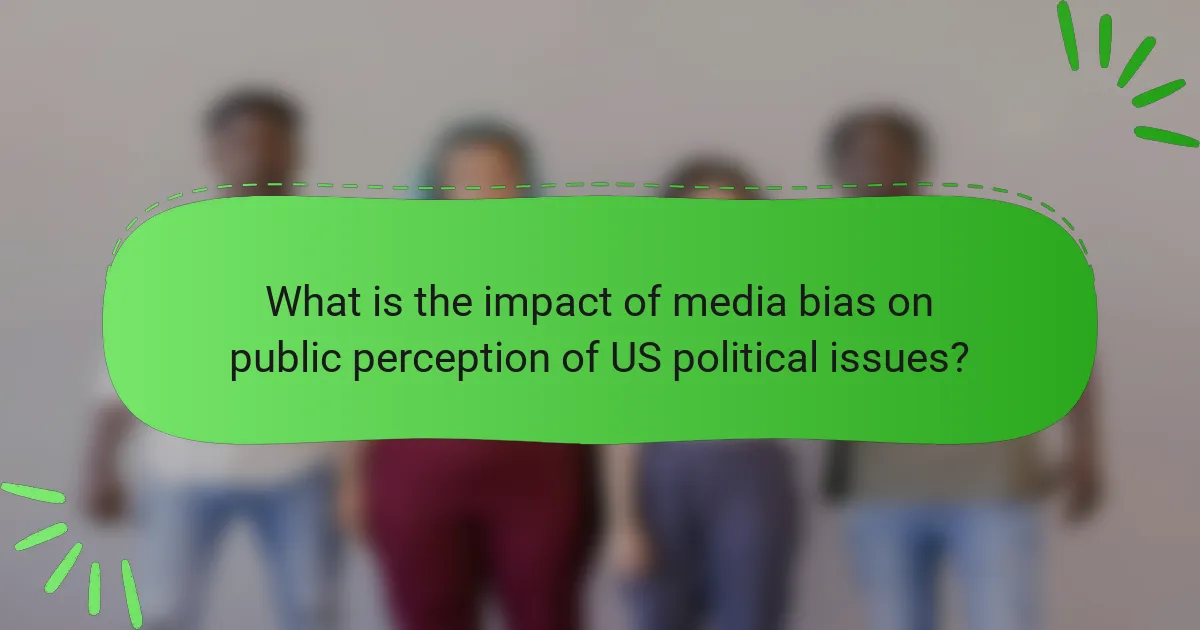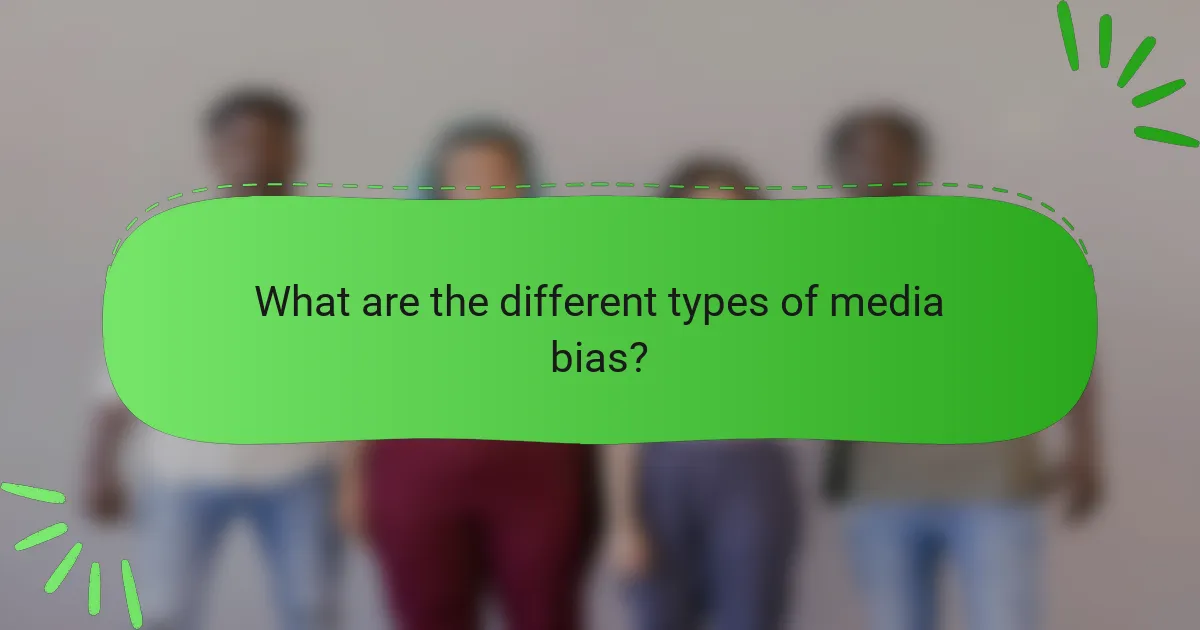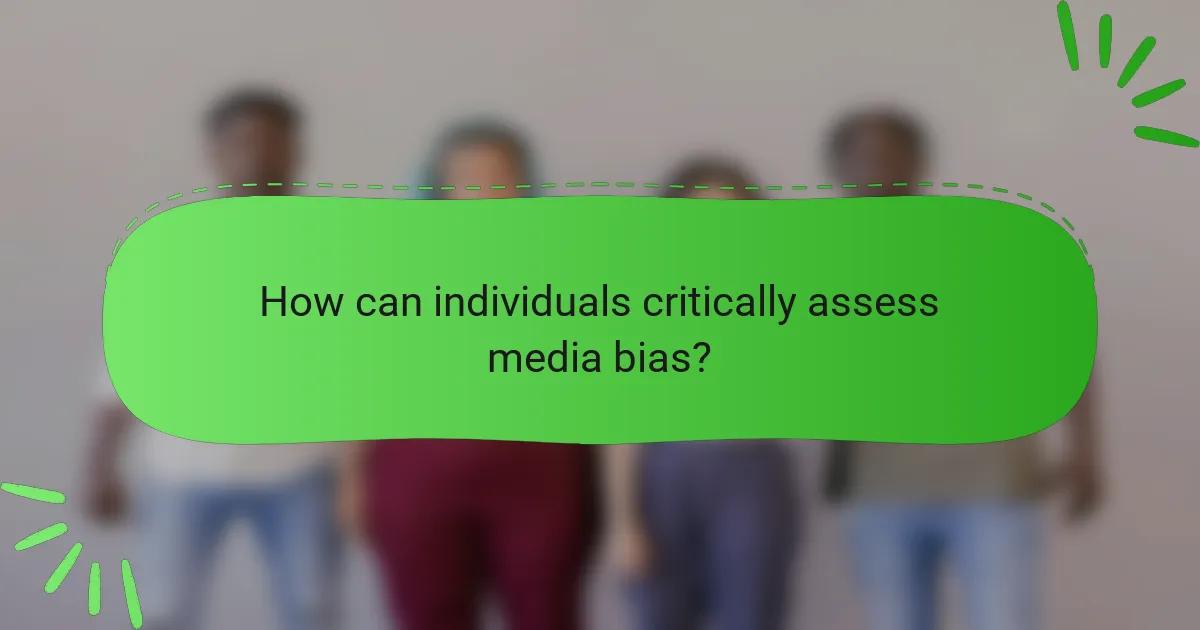Media bias refers to the perceived or actual bias of journalists and news producers in the mass media, significantly influencing public perception of political issues in the United States. This article examines various types of media bias, including selection bias, confirmation bias, framing bias, sensationalism, and bias by omission, and their effects on audience beliefs and behaviors. Research indicates that a substantial portion of Americans perceives favoritism in news coverage, which can impact voter decisions and trust in institutions. Additionally, the article highlights strategies for critically assessing media bias through language analysis, framing evaluation, source credibility checks, and comparative coverage analysis. Understanding these dynamics is essential for fostering informed civic engagement and enhancing critical media literacy.

What is the impact of media bias on public perception of US political issues?
Media bias significantly shapes public perception of US political issues. Biased reporting can lead to distorted views among audiences. For example, partisan news outlets often emphasize specific narratives. This can create echo chambers, reinforcing existing beliefs. Research shows that exposure to biased media affects political attitudes and behaviors. A study by the Pew Research Center found that 62% of Americans believe news organizations favor one side. This perception can influence voter decisions and trust in institutions. Additionally, media bias can polarize public opinion on key issues, such as healthcare and immigration. Consequently, understanding media bias is crucial for informed civic engagement.
How does media bias influence individual viewpoints?
Media bias significantly influences individual viewpoints by shaping the information that audiences receive. Biased reporting can lead to skewed perceptions of events, issues, or political figures. For instance, studies show that individuals exposed to partisan news sources often develop polarized opinions. Research from the Pew Research Center indicates that 62% of Americans believe news organizations favor one side in political debates. This favoritism can create echo chambers, reinforcing existing beliefs and reducing exposure to diverse perspectives. Consequently, media bias can distort public understanding of critical issues, affecting voting behavior and civic engagement.
What psychological mechanisms are affected by media bias?
Media bias affects several psychological mechanisms, including confirmation bias, cognitive dissonance, and the framing effect. Confirmation bias leads individuals to seek and interpret information that aligns with their preexisting beliefs. Studies show that people are more likely to accept information from biased sources that confirm their views. Cognitive dissonance occurs when individuals encounter information that contradicts their beliefs, leading them to rationalize or dismiss the new information. Research indicates that media bias can exacerbate this dissonance, making it harder for individuals to change their opinions. The framing effect influences how information is presented and perceived, altering individuals’ interpretations based on the context. Evidence suggests that biased framing can shape public opinion and decision-making.
How do emotional responses shape perceptions of political issues?
Emotional responses significantly shape perceptions of political issues. These responses influence how individuals interpret information and form opinions. For instance, fear can lead to heightened concern about specific policies, while anger can motivate activism. Research indicates that emotionally charged messaging is more memorable and persuasive. A study by the Pew Research Center found that emotionally resonant news stories lead to increased engagement and discussion among audiences. This suggests that emotions play a crucial role in determining which political issues gain traction in public discourse.
Why is understanding media bias important for democracy?
Understanding media bias is crucial for democracy as it influences public perception and decision-making. Media bias can shape narratives and affect how information is presented to the public. When citizens are exposed to biased reporting, it can lead to misinformation and a distorted understanding of political issues. Studies show that biased media can contribute to polarization among the electorate, undermining democratic discourse. A 2019 Pew Research Center study found that 62% of Americans believe news organizations favor one side. This perception can erode trust in media and institutions. Informed citizens are essential for a functioning democracy, and recognizing media bias helps individuals critically evaluate information.
What role does media play in shaping public discourse?
Media plays a crucial role in shaping public discourse by influencing perceptions and opinions. It serves as a primary source of information for the public. Through news coverage, media highlights specific issues, framing them in particular ways. This framing can affect how audiences understand and engage with those issues. For example, studies show that media portrayal of political events can sway public opinion significantly. Research by the Pew Research Center indicates that 62% of Americans get news from social media. This reliance on media shapes discussions and debates within society. Furthermore, media can amplify certain voices while marginalizing others, impacting which narratives dominate public conversation.
How can media bias affect voter behavior and decision-making?
Media bias can significantly influence voter behavior and decision-making. Biased reporting can shape public perceptions of candidates and issues. This can lead voters to favor one candidate over another based on slanted information. Research shows that individuals exposed to biased media are more likely to hold polarized views. For example, a study by the Pew Research Center found that partisan media consumption correlates with increased political polarization. Biased narratives can distort facts, affecting how voters interpret political realities. This can result in misinformed voting choices. Additionally, media bias can create echo chambers, reinforcing existing beliefs among voters. Ultimately, biased media can undermine the democratic process by skewing voter understanding and engagement.

What are the different types of media bias?
Media bias refers to the perceived or real bias of journalists and news producers within the mass media. There are several types of media bias. These include selection bias, where certain stories are chosen over others, and confirmation bias, where media outlets favor information that supports their existing beliefs. There is also framing bias, which involves presenting information in a way that influences perception. Another type is sensationalism, where exaggerated stories are prioritized to attract attention. Additionally, there is bias by omission, where important facts are left out of reporting. Each type of bias can significantly impact public perception, especially in political contexts.
How do partisan biases manifest in media coverage?
Partisan biases in media coverage manifest through selective reporting and framing of news stories. Media outlets may emphasize certain facts that align with a particular political ideology while downplaying or omitting opposing viewpoints. For example, studies show that conservative outlets often highlight issues like tax cuts or gun rights, whereas liberal outlets may focus on social justice or climate change. The language used in headlines can also reflect bias, with emotionally charged words influencing public perception. Research by the Pew Research Center indicates that audiences are more likely to trust news sources that align with their political beliefs. This creates an echo chamber effect, reinforcing existing biases among viewers. Additionally, partisan biases can lead to a lack of diversity in perspectives presented, which skews public understanding of complex political issues.
What examples illustrate partisan bias in news reporting?
Examples of partisan bias in news reporting include the coverage of the 2016 U.S. presidential election. Outlets like CNN and MSNBC often portrayed Hillary Clinton favorably, while Fox News focused on negative aspects of her campaign. In contrast, Fox News presented Donald Trump in a more positive light, emphasizing his outsider status. Another example is the differing coverage of the COVID-19 pandemic. Some outlets criticized the Trump administration’s response, while others downplayed the severity of the virus to align with political agendas. These patterns indicate how media can reflect and amplify partisan perspectives. Studies have shown that audiences tend to gravitate toward news that reinforces their existing beliefs, further entrenching partisan divides.
How does partisan bias affect the framing of political issues?
Partisan bias significantly influences how political issues are framed. Media outlets often present facts and narratives that align with their political affiliations. This selective framing can shape public perception by highlighting certain aspects while downplaying others. For instance, studies show that conservative media may emphasize crime rates in discussions about immigration, while liberal media might focus on humanitarian impacts. This divergent framing leads to polarized public opinions. Research from the Pew Research Center indicates that individuals consume news that reinforces their beliefs, further entrenching partisan biases. Consequently, partisan bias not only affects the narrative but also shapes the overall discourse on political issues.
What is the difference between overt and subtle media bias?
Overt media bias is explicit and easily identifiable. It often involves clear favoritism or prejudice in reporting. For instance, a news outlet may endorse a political candidate outright. This type of bias is apparent in the language used and the selection of stories. Subtle media bias, on the other hand, is more insidious and less obvious. It can manifest through the framing of stories or the choice of sources. For example, a report may highlight certain facts while omitting others. This selective presentation influences audience perception without direct endorsement. Both forms of bias shape public opinion on political issues. Research indicates that audiences may be unaware of subtle bias, making it particularly impactful.
How can subtle bias be identified in news articles?
Subtle bias in news articles can be identified through language choice, framing, and source selection. Language choice refers to the connotations of words used. For example, describing a protest as a “riot” versus a “demonstration” can convey bias. Framing involves how a story is presented. An article may highlight certain facts while omitting others, influencing reader perception. Source selection is critical; reliance on specific experts or organizations can skew representation. Studies show that biased reporting can shape public opinion, as demonstrated in research by the Pew Research Center. This research indicates that perceptions of news credibility vary based on reported biases.
What are the consequences of subtle bias on public understanding?
Subtle bias can significantly distort public understanding. It influences how information is perceived and interpreted. This can lead to skewed perceptions of political issues. For instance, research shows that biased media framing can shape public opinion. A study by the Pew Research Center found that individuals exposed to biased news are more likely to hold polarized views. Subtle bias can also reinforce existing stereotypes and misconceptions. This can hinder informed decision-making among the public. Overall, subtle bias complicates the objective understanding of political realities.

How can individuals critically assess media bias?
Individuals can critically assess media bias by analyzing the language, framing, and sources used in news articles. Language choices, such as emotionally charged words, can indicate bias. Framing refers to how stories are presented, which can shape perceptions. Evaluating the sources cited in articles helps determine credibility and potential bias. Fact-checking claims against reputable sources provides additional context. Comparing coverage across multiple outlets reveals differing perspectives. Understanding the ownership and funding of media organizations can also expose potential biases. Research shows that awareness of these factors can enhance critical media literacy.
What strategies can be employed to evaluate news sources?
To evaluate news sources, employ strategies such as cross-referencing information, checking author credentials, and analyzing the source’s reputation. Cross-referencing involves comparing information from multiple reputable sources to verify accuracy. Checking author credentials ensures the writer has expertise in the subject matter. Analyzing the source’s reputation includes assessing its history of bias and reliability. Fact-checking websites can also provide insights into the credibility of specific claims. According to the Pew Research Center, 62% of Americans say they often check multiple sources before forming an opinion on news stories. This approach enhances critical thinking and reduces the influence of media bias on public perception.
How can fact-checking resources aid in identifying bias?
Fact-checking resources aid in identifying bias by providing verified information and context. They analyze claims made in media sources for accuracy. By comparing multiple sources, they reveal discrepancies in reporting. This helps to highlight potential biases in how information is presented. For example, fact-checkers often assess the framing of political statements. They examine whether certain viewpoints are favored or marginalized. Research shows that exposure to fact-checked information can reduce susceptibility to biased narratives. Studies indicate that informed audiences are better equipped to recognize bias in media.
What questions should readers ask to discern bias in reporting?
Readers should ask several questions to discern bias in reporting. They should consider who owns the media outlet. Ownership can influence content direction and perspective. Readers should also evaluate the language used in the reporting. Emotional or charged language may indicate bias. It is important to check the sources cited in the article. Reliable reporting typically includes a variety of credible sources. Readers should assess whether opposing viewpoints are represented. Balanced reporting often includes multiple perspectives on an issue. Additionally, examining the context of the story is crucial. Context can reveal underlying motives or biases. Lastly, readers should consider the timing of the report. Timeliness can affect how information is presented and interpreted.
How can media literacy improve public perception?
Media literacy can improve public perception by enabling individuals to critically analyze information. It equips people with skills to discern biases in media content. This understanding helps mitigate the influence of misinformation. For instance, a study by the Pew Research Center found that media-savvy individuals are less likely to believe false news. Enhanced media literacy fosters informed decision-making among the public. Consequently, this leads to a more accurate understanding of political issues. Improved public perception can result in healthier democratic engagement. Overall, media literacy acts as a tool for enhancing critical thinking in media consumption.
What educational initiatives promote media literacy?
Educational initiatives that promote media literacy include programs like Common Sense Media and the News Literacy Project. Common Sense Media provides resources for educators to teach students about evaluating media sources. The News Literacy Project focuses on helping students discern credible news from misinformation. Both initiatives aim to equip learners with critical thinking skills. Research shows that media literacy education can reduce susceptibility to fake news. A study by the Stanford History Education Group found that students often struggle to evaluate online information. These initiatives address that gap by providing structured learning experiences.
How does increased media literacy affect political engagement?
Increased media literacy enhances political engagement. Individuals with higher media literacy can critically evaluate information sources. This ability leads to informed decision-making in political contexts. Studies show that media-literate individuals are more likely to participate in elections. They also engage in discussions about political issues more frequently. Research indicates that media literacy programs can boost civic participation. For example, a study by the Pew Research Center found that media-savvy individuals are more likely to vote. This correlation underscores the impact of media literacy on political involvement.
What practical steps can individuals take to mitigate the effects of media bias?
Individuals can mitigate the effects of media bias by diversifying their news sources. Consuming information from multiple outlets reduces the risk of being influenced by a single perspective. Engaging with both mainstream and independent media helps to present a fuller picture. Fact-checking claims using reputable organizations like Snopes or FactCheck.org enhances understanding. Developing critical thinking skills enables individuals to analyze the information critically. Additionally, discussing news with others can reveal different viewpoints and challenge biases. Lastly, being aware of personal biases increases media literacy and helps in recognizing biased reporting.
Understanding the impact of media bias on public perception of US political issues is crucial for informed civic engagement. The article explores how biased reporting shapes individual viewpoints, influences voter behavior, and polarizes public opinion. It examines psychological mechanisms affected by media bias, such as confirmation bias and emotional responses, while highlighting the importance of media literacy in mitigating these effects. Additionally, it discusses various types of media bias, including partisan bias and subtle bias, and offers strategies for individuals to critically assess media sources and improve their understanding of political issues.